Categories
- Arroces
- Cajas de Navidad
- Chocolate. Jam
- delicatessenMED Gifts
- delicatessenMED Packs
- Iberian Ham
- Iberian Sausages
- Manchego cheese
- Olive oil flavored
-
Olive Oil. Salt. Vinegar
- Olive Oil
-
Olive oil flavored
- Aceite sabor Aguacate
- Olive Oil Café Kenya flavor
- Olive oil Chive flavor
- Olive oil flavor Chocolate
- Olive oil flavor Ginger
- Olive oil flavor Horchata
- Olive oil flavor Mango
- Olive oil flavor Orange & Saffron
- Olive oil flavor Pomegranate
- Olive oil flavor Tomato Raf
- Olive oil flavor Wasabi
- Trays with 5 units
- Sea Salt flavored
- Vinegar
- Packs 'Open & Serve'
- Precooked Meals
- Saffron and Products
- Salted food
- Sugar cane "colored"
- Truffle and Products
Search
Information

I want to know more about Ham
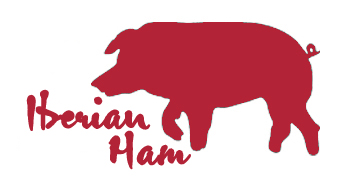
- History
- Types of Ham
- Non-official clasifications
- Denominations of Origin
- Beneficial properties of Ham and Nutritional Info.
- Stages in the production of Iberian ham
- Main parts of Iberian Ham
- The cut of ham step by step
- How to serve and maintain a ham
- How to choose a ham
1. History
ANCIENT TRADITION
Undoubtedly, the delicious cured ham captivated the senses and stomachs of the Romans who inhabited the peninsula since the second century BC. The practice of curing salt pork, laid the foundation for the development of one of the most popular snacks in the world.
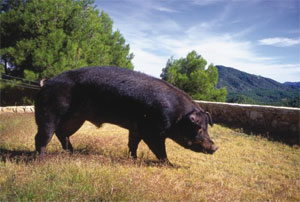
Its place of honor in Spanish cuisine has remained undisturbed over the centuries, and writers such as Cervantes, who did not hesitate to mention this delight in their acclaimed "Don Quixote", have played a major role when to make known the unique qualities associated with this product.
So, what was once a very well kept secret, has now become a delicacy pantry essential in any self-respecting gourmet palate.
The present production techniques date back to ancient methods, albeit adapted to the health regulations in force, and follow the basic processes of sacrifice, healing and maturation.
The taste, quality and price of ham vary greatly depending on:
The kind of pig from which it comes from
Diets that has followed the animal
The leg-front or rear-has been used to manufacture
The maturation time that has undergone the ham
The most important factor is undoubtedly the kind of pork. According to the breed of the animal, the following categories of hams:
White pig: Serrano ham, cured ham, am of Bodega or country ham
Iberian pig: Iberico
Classification of Ham from White pork
Hams obtained from selected white pigs have a softer texture and a sweetish aroma and flavor than Iberian hams. Its price is significantly lower.
This type of ham can be enjoyed alone, but sometimes also used in the kitchen. When it is still tender, offers a look similar to other types of hams like Parma, and is in every supermarket. However, even in this category the difference in quality can be enormous.
We can find:
Serrano Ham without guarantee of origin:
- Serrano Ham
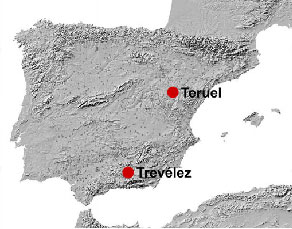
Serrano Ham with guarantee of origin (protected geographical indication):
- Serrano Ham from Trévelez
- Serrano Ham from Teruel
Serrano ham without Protected Geographical Indication is the simplest in its class. Although it is obviously possible to enjoy excellent pieces, it is also true that this is the category where it is easier to find low quality hams, industrially manufactured and contain artificial additives.
Instead, the hams that have an official certificate of origin offer the guarantee that they come from a specific breed of pigs with a minimum weight, which have been prepared in a geographical area in which there are certain specific characteristics, the process follows a traditional method and have a minimum curing period.
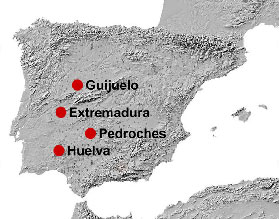
These hams can be exceptionally tasty, and their qualities are considerably higher than those of industrially processed hams. They are recognizable by their delicate taste and complex, fragrant aroma, its yellow marbling and texture soft and shiny.
Classification of Iberian ham
Iberian ham deserves a separate chapter. It's totally different not only to Serrano ham, but to all kinds of hams that are produced elsewhere in the world.
After overcoming a healing period of two years, the flavor and aroma of cured ham is so complex, peculiar and intense, that this product deserves the same consideration and honor than the white truffles, Beluga caviar or other comparable delicacy. In fact, this is already one of the most renowned Spanish delicacies among the most demanding gourmets.
Iberian ham is obtained from native Iberian pig. This race, a close relative of the boar, has inhabited the south-west of Spain for centuries. In these meadows full of oaks, is where the Iberian pig finds their favorite food: acorns. The animals enjoy a life of privilege, wandering all day through forests of great beauty and exercising, by the way, its muscles. It is in this organ where hides one of the secrets behind the flavor so characteristic of Iberian ham.
Indeed, the natural ability to transform the Iberian pig fat healthy acorn in veins that run through its muscle tissue is what gives the Iberico ham its exquisite marbled texture and aroma. The meat is streaked with thin lines of fat, the taste of which provides some clues about the kind of food that is in the natural environment that has bred the animal: acorns, grass, roots, tubers and mushrooms. In addition, the fat of Iberian ham has the property to practically melt at room temperature, and it literally melts in your mouth.
In terms of quality, the main factor to consider with respect to the Iberian ham, is how the animal has been fed:
Iberian ham of Bodega Cebo: The Iberian pig that was obtained has been fed mainly on grain and feed.
Iberian ham of Bodega Cebo Field: Distinguish between pigs reared bait to those who take their food is not in feedlots, at different times or all the time, but those who eat outdoors, as the name in the field .
Its curation time is about 24 months
Iberico Recebo: It comes from pigs fed on acorns in pastures, but in recent months also have a supplementary feeding with feed properly authorized.
Iberian Ham of Bellota: It has been obtained from an Iberian pig fed exclusively on acorns until they are slaughtered. They are animals who walk freely through the meadows and enjoy the acorns.
Its curation time is about 36 months
Iberian Ham of Bellota Gran Reserva: The same as the one mentioned before but it has more time of curation.
Like to Serrano ham, for Iberian ham there are also official seals of quality (Appellations of Origin) to ensure the place of origin and certify that the ham is made following traditional methods:
Iberico ham without designation of origin:
Iberian ham of Bodega
Iberico ham of Bodega designation of origin:
Cebo ham of Bodega Guijuelo
Extremadura Iberico
Iberico ham from Huelva
Iberian Ham Pedroches
3. Non-official clasifications
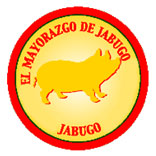
Apart from that there are different trade names known to the Spanish consumer but often confused by its ambiguity, as would those of "Pata Negra ham," "Jabugo ham," "5J ham" or "Valderado", "Joselito". .. these last three are recognized brands in Spain. To assess the quality there is only the official classification, it must also be reflected in the identification label on the piece.
Iberian Ham
Iberian Ham D.O. Huelva
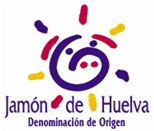
The production area is composed of 31 municipalities, all in the region of La Sierra and at altitudes of between 500 and the 1042 meters above sea level. Its climate is influenced mountain Mediterranean and Atlantic, with high rainfall, cool summers and mild winters, and a very diverse vegetation of olive trees, palm trees, chestnut, pine and oak and dominance of the oak.
One of the distinguishing characteristics of this ham is the impact they have on their aroma and taste the fruits of this tree, which give them a special touch.
The Designation of Origin supports pigs in the provinces of Huelva, Seville, Cordoba, Cadiz, Malaga, Caceres and Badajoz, and its optimum maturity period is shorter than that needed in Guijuelo.
The most famous site dedicated to the Designation of Origin ham is Jabugo
Iberian ham D.O. Los Pedroches

The hams and shoulder cuts are from Iberian pigs in all its strains, admitting those animals that have a minimum of 75% of the breed and a maximum of 25% of the breeds Duroc and Duroc Jersey.
Minimum curing of the parts is 12 months for shoulder cuts and 18 months for hams.
The hams and palettes are characterized by their external form elongated and stylized. Leather profiled by the Serrano cut "V". Retain the claw for easy identification.
Its meat is very salty or sweet taste. The aroma is pleasant and characteristic. At the cut can see the purple pink meat and fat infiltration in muscle mass. Its texture is very fibrous, its fat is bright pinkish-white or yellowish.
Iberian ham D.O. Guijuelo (Salamanca)

Guijuelo lies southeast of the province of Salamanca. On an altitude of over one thousand meters, is the most important Spanish region of the Iberian pig crafts since elaborated more than 65 percent of national Iberian products.
The location of Guijuelo, makes its climate to be predominantly continental, with the peculiarity that the winds come from the four cardinal points due to lack of vegetative protection.
The development of the ham can be done in the 77 municipalities located southeast of the province of Salamanca in which environmental conditions are similar, although in some cases, such as Ledrada, height above sea level is lower.
The consequence of this is that the maturation process of the ham is longer in practice, although the regulation takes practically the same limits as that of Huelva.
Meat has a sweet, fragrant, creamy in the mouth leading to an explosion of delicate aromas.
Salt being the shortness of its strongest features, the Iberico ham of Bodega, with Designation of Origin "Guijuelo" has cut numerous veins interspersed between its "grasilla" lean meat, with colors ranging from red to purple and pink pale. Its bright golden bacon, reveals the low melting point of fat acorns.
Externally recognized by the shape and color of its fat, the greasiness of fat walls and fungal flora green, bluish or grayish green, next to cut "V" (ham) established by the Regulations, as well as the stylized form and fineness of its cane, topped with black hooves .
Iberian ham D.O. Dehesa de Extremadura
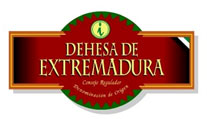
The hams and shoulder cuts of the designation of origin Dehesa de Extremadura come from pure Iberian breed pigs, or the Iberian breed cross Duroc-Jersey (with 75% Iberian blood and 25% of the Duroc-Jersey).
This area spans the entire community of Extremadura, which has about one million hectares in the provinces of Cáceres and Badajoz, where there are limited fields with holm and cork oaks where pigs can feed on acorns.
There are 85 municipalities that engage in the development and maturation of hams and shoulder cuts, 40 in Badajoz and 45 in Caceres, especially in the Southwest Mountains Badajoz, Ibor-Villuecas, the southern Gredos, the Sierra and the Sierra Montánchez San Pedro.
They are characterized by their stylized outer thin reed, long and claw. Its color ranges from pink to purple, with a slightly salty or sweet flavor, very delicate on the palate, with a slightly fibrous texture and fat shiny and smooth, aromatic, pleasing flavor and soft to the touch. The aroma is pleasant and full of nuances.
Ham with D.O. Teruel
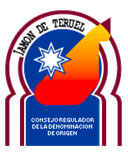
The "Jamón de Teruel" was the first in Spain supported by a designation of origin. The birth of the denomination's main objective is to achieve a high quality product, subjected to a rigorous selection process and curing.
The province of Teruel is famous for the quality of its pork products and especially their hams. Orographic characteristics and climate are ideal for the natural curing process of the ham.
The production area consists of those municipalities in the province of Teruel with an average altitude not lower than 800 m.
Ham is elongated, shaped and rounded. Its weight will be greater than 7 kg, with a peculiar flavor, delicate, slightly salty. Its aroma is soft, pleasant, charming and appetizing appearance, for its brilliant color when cut. Its fat: consistent, creamy, shiny, whitish-yellow, aromatic and pleasant taste.
Ham with D.O Trévelez
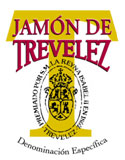
The production area is located east of the province of Granada. The municipalities that comprise it are: Trevélez, Juviles, Busquístar, Pórtugos, La Taha, Bubión, Capileira and Bérchules.
The type of cattle suitable for the production of hams destined for the production of ham protected by special designation will be obtained from pigs in crossbred Landrace, Large White and Duroc-Jersey.
Trevélez ham owes its particular organoleptic characteristics to the natural environment (lower middle area of the Natural Park of Sierra Nevada) in which it occurs and this environment, climate and vegetation, which influences the development of a specific microbial flora. Well above the 1,200 and 1,900 m, an area where there are hams lie Trevélez oaks and high number of endemic plant species can be found in Sierra Nevada. With respect to climate, in the region, and between 1,200 meters and the peaks of Sierra Nevada is the cold zone, with abundant snow in winter and cool in summer temperatures.
The leg has a rounded shape. The meat is red and has a shiny appearance when cut, with partial fat infiltration in muscle mass. Its flavor is delicate, slightly salty. Its creamy consistency has a fat, shiny, with a yellowish white color and pleasant flavor.
5. Beneficial properties of Ham and Nutritional Info.
- Its low calorie meat, protects the heart and circulatory system, lowers cholesterol and is rich in all kinds of vitamins.
- It is an antioxidant, is high in vitamin E.
- Its fat is rich in monounsaturated fatty acids and oleic acid, which keeps us protected against the cardiovascular diseases.
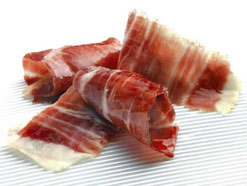
- Complete source of vitamins, as it provides vitamins B1, B6, B3, B12 and folic acid, which is very beneficial for the nervous system and for brain function.
- It is rich in minerals essential for bone and cartilage, and if not, it is also a recommended food on low-calorie diets, since it has only about 150 calories per 50 grams.
- Contains 50% more protein than fresh meat and fat is composed of Oleic Acid
- It is rich in iron, magnesium, calcium and phosphorus
6. Stages in the production of Iberian ham
Salting
It aims to incorporate sea salt to muscle mass, favoring the dehydration of the limbs of the pig and its conservation. The approximate duration in the salt is one day per kilo of weight, staying at a temperature between 1 º and 5 º C and relative humidity around 80-90%.
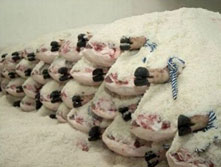
Settlement
When the ham is removed from the stack of salt, has taken all the salt is going to have until the end of the process. However it is concentrated in the surface while the interior regions contain virtually no salt. So we need a period where for post salting diffusion process tends to a uniform distribution of the salt concentration to reach the exact point of salt. The minimum duration of post-salting, is variable and goes depending of the fat content of each piece since salt penetration by diffusion is strongly influenced by the presence of fat. Although generally this process usually lasts between 40 and 60 days.
Another important factor is that while it is producing salt penetration into the ham, there is a process of water outlet to the outside, with consequent loss of moisture from the surface. It is therefore necessary to have tight control of relative humidity of the chamber where the maintenance of the hams, which from 5 to 1 ° C starting to evolve to 25 or 30 ° C at the time they are moved to the drier natural.
Washing with warm water
Is performed to remove the salt surface, for which the hams are introduced into a container in which there are brushes, barbed which aid this process. Currently there are automatic machines to wash and rub of parts.
It is important that the salt is clean and that the washing is correct to prevent the deposition of the salt in the outside of ham inhibits the growth of plants. So far, there has been a good process of the ham that can serve for any type that is developed, and now the problems begin, as the ham will be exposed, with nothing to protect him, given the low value that can be assigned antiseptic to salt to climatic variations, bacterial contamination, environmental assaults, parasitism, etc..
Drying and curing
The natural drying parts pass a rigorous control of ventilation and temperature that can last between 6 and 9 months with temperatures between 15 ° and 30 ° C. This resting period favors the natural fusion of the fat of adipose protection, achieving a uniform distribution of fat in muscle tissue. In recent months begins to take its unique flavor and aroma.
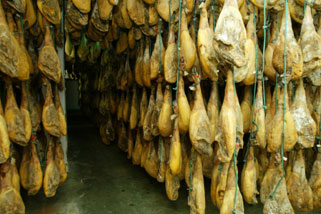
Aging in cellar
After a preliminary classification based on weight, quality and conformation, hams and shoulder cuts go to the cellar where it concludes the final phase of healing, maturing slowly. Remain between 6 and 18 months according to the above classification. At this stage the temperature ranges between 15 ° and 20 ° C and relative humidity around 60-80%.
Both a good drying natural, like a good wine, must support these operations in an absolutely natural, without action by any procedure which is not by tradition and practice.
It's a matter of sensitivity, since the final result will depend on the characteristics of the dryer itself and the ability of people working on it, and with total dedication and experience shows, have to combine the factors of altitude, microclimate , moisture content, daily variations in temperature and air velocity.
Maza
The portion of the leg of Iberian ham that has greater amounts of meat, is also considered the richer, since that's where the meat is extracted more tasty, tender and juicy. Normally provides a greater degree of infiltration of fat. The area is very appreciated sensorially and offers quite performance.
Contramaza
This is the area of the workpiece opposite the club. Is narrower and usually more seasoned, with more consistency. Both surface and internally offers little fat. Does not have high performance.
Babilla
Ham has fewer than the "club" this is due to be bounded by the femur and hip bones. This part is less juicy than the hub, so it is recommended to start with ham when its use will be extended in time, in order to keep better and take the best part.
Punta
Is the distal part of the ham completely opposite to the hoof. It is very tasty and has a good level of fat. However, if not sufficiently protected from fat, it can sometimes be a bit salty.
Jarrete and caña
Usually used to extract diced ham, the texture of the meat is tough and fibrous and has different tastes.
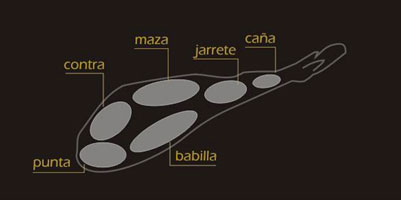
8. The cut of ham step by step
A good cut is essential to fully enjoy a ham. There are no secrets: you only need the right tools, patience and practice.
As mentioned above, it is important to use a ham holder to hold and fix the ham when cutting. Not only is safer, but also facilitates the work considerably. The carving knife should also be appropriate, with a long, narrow and flexible blade.
Whether short-hand as tradition-or machine, the secret is getting very thin slices and thin, almost transparent, which can practically melt in the mouth and thus extend its aroma and flavor.
1. The first aspect to consider is how quickly you foresee eating your ham:
If you eat the piece immediately, in 1 or 2 days, place the ham with the hoof facing upwards and remove all bark. Thus, begin to cut through the most juicy ham.
If the ham is to be consumed over a long period of time, place with the hoof facing down and remove only the piece of bark that is necessary as you go eating ham. By placing the ham in this position, you will begin to cut it hand drier, so avoid it becoming too dry before use.
2. With a strong, wide-bladed knife make a deep cut on the knuckle (thinner area, close to the hoof) and remove the piece of crust and upper fat layer.
IMPORTANT: Keep a few pieces of fat, since that will be used to cover the part of the ham that has been cut, and thus prevent it from drying out.
3. With the carving knife, start cutting slices of ham about 6-8 inches and as thin as possible. This must be done carefully and based on very short saw movements and smooth. Always keep a cutting line straight and horizontal, preventing to curve the center. As you cut the ham, remove only the minimum area of rind and fat. When finished cutting, protect the piece of ham that is exposed to the pieces of fat that you have booked previously.
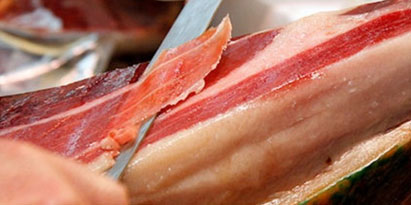
4. When you get to hipbone, make a deep cut with a short knife kitchen.
5. The flesh surrounding the bone can be cut in pieces, since it is difficult to slice it. It is a perfect cover, and can also be added to stews or a tasty salad.
6. When you're done with this part of the ham, you can turn around and continue cutting it in the usual way.
7. Once you get the ham bone, bone-sawing can ask your butcher or common-do it for you, for use in stews and soups. If you want to you can freeze these pieces of bone.
9. How to serve and maintain a ham:
The first thing to do after buying a ham, remove all packaging to submit the piece.
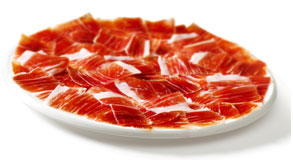
Should be consumed as soon as possible and not let it go longer than 3 days without cutting to prevent rancidity. If over time has mites, wash the piece with a damp cloth and apply oil on the surface.
Always cover the cut with pieces of fat to prevent drying.
The ham should be eaten at room temperature - about 21 º C. As you cut the ham, place the slices overlapping on a plate that is not too cold or too hot. Avoid stacking the slices.
The ham itself is a delicious dish, but can also be enjoyed along with a few slices of bread seasoned with good extra virgin olive oil or, as is usual in Catalonia, on a slice of bread with tomato.
Cut the ham only going to consume at the moment. If you cut more than necessary, cover the leftover slices in foil and store in refrigerator. Before eating, remove it from the refrigerator at least two hours before it will reach room temperature.
There may be tiny, white spots infiltrated in the flesh of the ham. Are crystals of an amino acid tyrosine and therefore do not indicate a problem with the ham. Quite the contrary, many experts believe these white spots are a sign of quality.
The ham actually fails to expire, although eventually dries. In proper storage conditions, the ham may last about a year, although it is advisable to eat in two or three months.
To keep the ham in perfect condition, place it in a dry, cool, airy room temperature. Do not store in the fridge, unless it is a boneless ham.
It is normal that mold appears on the outside of the cortex. This is natural and does not damage the ham. Is easily removed with the help of a damp cloth.
Always protect the meat from the ham that has been exposed with pieces of fat and reserved cortex. Also, you can cover the ham with a dry cloth.
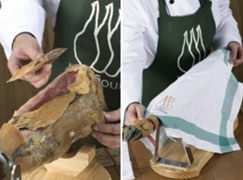
If you're not sure what kind of ham is best for you, we suggest you follow the following path:
1. FORMAT: whole or boneless ham?
Choose a boneless ham if:
You do not have space in your kitchen to save a whole ham
Do not want to see a pig's foot in your kitchen!
Prefer the convenience and speed of a cutting machine
Choose a whole ham if:
You enjoy the pleasure of authenticity and what is traditional
Want to experience the ritual of cutting of the ham
Prefer to savor slices of the highest quality
2. TYPE: Iberian cured ham or Serrano ham?
Choose a Serrano ham if:
The price is the main factor
You want to use for cooking ham
Prefer a milder flavor
Choose an Iberico ham if:
Quality is the main factor
Consume raw ham
Prefer a rich, intense flavor
3. QUALITY IBERIAN: Bait field or acorn?
-
Choose an Iberico ham bait field if:
Looking for a good compromise between price and quality
Choose an Iberico ham if:
Looking for the best quality
4. SIZE: Ham or palette?
Choose a palette if:
It is for one or two people, or foresee eat a small amount of ham every day
Want to first test a small piece before buying a whole ham
Choose a ham if:
It is for several members of a family or a restaurant, or foresee eating a considerable amount of ham every day
Want a lower fat meat
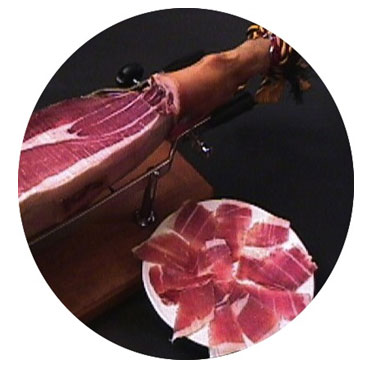
Cart
No products
Shipping*
0,00 €
Total
0,00 €
Other destinations, please check Shipping Info









